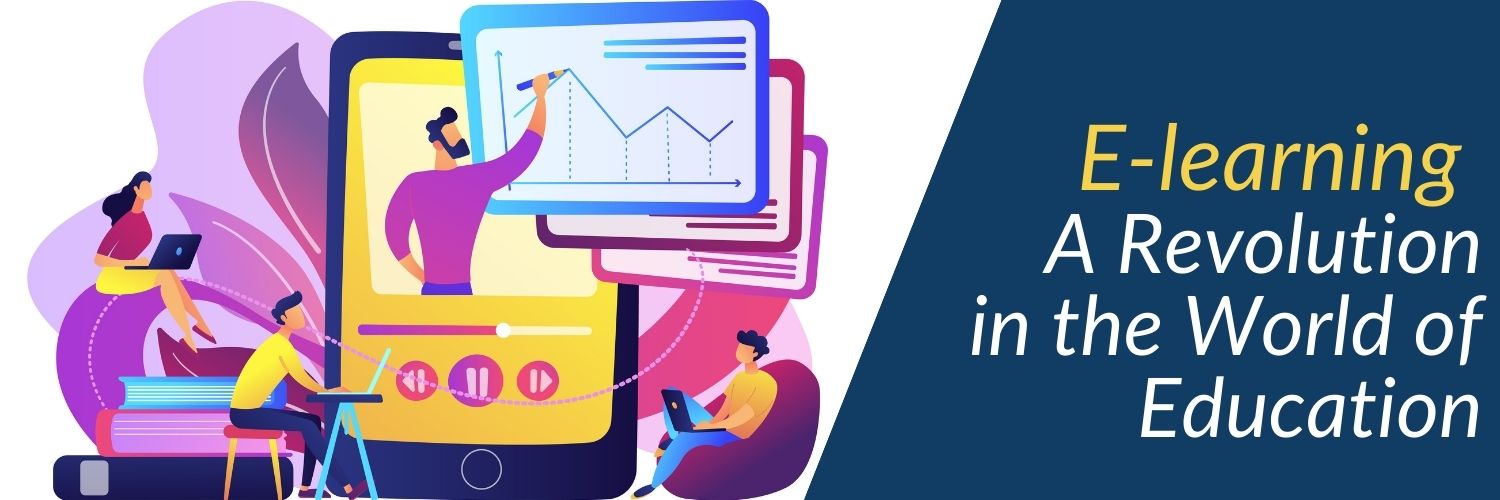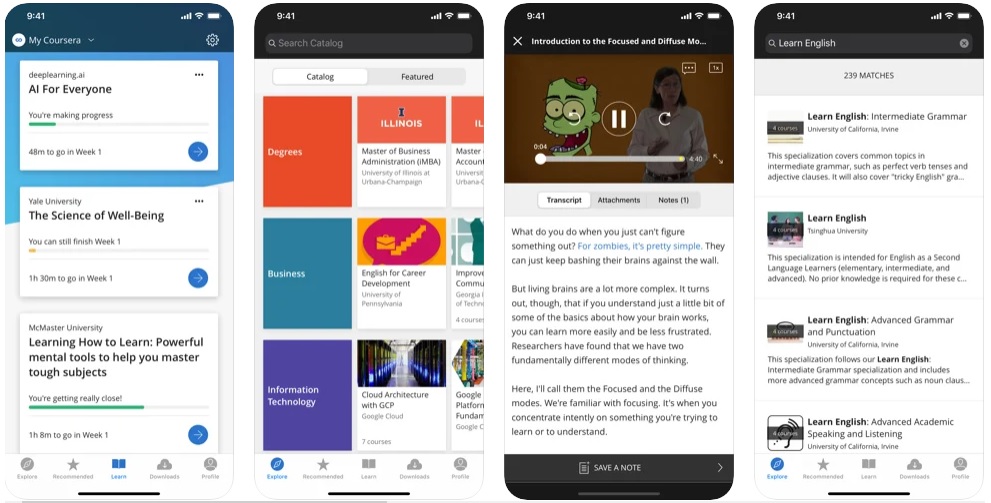
The academic landscape was restricted to brick schools and colleges several years ago. Most of the students and learners have not been able to study in the schools and colleges of their aspirations because of the increasing costs or stringent admission criteria. The ongoing Pandemic has brought to a stalemate foreign trade and bogged down the global economy. There are two sectors amid these turbulent times that have developed broader business opportunities than it has ever been. The sectors are the Healthcare Sector, and the second one is the Education Sector. Although they are inside, individuals are looking forward to such facilities. It appears that the demand for eLearning will expand beyond the estimates of the reports carried out well before the continuing Pandemic.
According to Forbes, the global eLearning market is predicted to reach 325 billion dollars by 2025. There is no doubt that too many startups are rising now and then, and many have innovative approaches, features, and skills. Creating an eLearning application wasn’t enough to have such a tremendous billion-dollar vision or idea. It’s a blend of a brilliant plan with a secure and practical framework that transforms a basic project into a huge one, much the same as Coursera or any other.
So well, how to develop an eLearning application like Coursera that will succeed in the long term? What models to use? What are the features must-haves? How much does it cost to develop an application? What technologies need to be used? These are some common questions that every individual comes to mind when building an eLearning application similar to Coursera.
In this blog, we’ll be covering all these questions. If you are sailing in the same boat, then the quest is over. Find out the answers to all questions below, and learn how to build the next disruptive eLearning application like Coursera.
So let’s start with the basics first.
What is an eLearning Application?
 eLearning, also is known as electronic learning, Learning something new via computers, tablets, or mobile phones connected to the internet. Students don’t have to be present in the classroom physically. They can learn at their own pace. Digital education channels are becoming an effective and easy method today. Let’s move forward and discuss the core benefits of eLearning applications.
eLearning, also is known as electronic learning, Learning something new via computers, tablets, or mobile phones connected to the internet. Students don’t have to be present in the classroom physically. They can learn at their own pace. Digital education channels are becoming an effective and easy method today. Let’s move forward and discuss the core benefits of eLearning applications.
- Flexibility.
- Self-placed mode.
- Lower costs.
Besides these core benefits, there are some common challenges in eLearning application are:
- Lack of facial interaction.
- Quality of content.
- Tech dependent.
- Lack of Self-discipline.
Let’s move forward and discuss:
How Coursera Started?
The journey started in 2012 by two Stanford Professors of the Computer Science Department. The e-programs offered by Stanford inspired both the professors. The first university of its stature to provide course material was Stanford, and now they draw a more extensive student base.
Let’s discuss the offerings by Coursera.
- Provides world-class learning experience.
- Multi-Lingual educational content.
- Offers free and premium courses.
- Rating system.
The business model of Coursera
Coursera started with few schools and universities, but now the time is changed; they’ve begun collaborating with governments, corporates, and various education partners. Let’s have a look at models on which Coursera majorly works.
- Specializations – Here, under this model, to get training in a particular subject, students or learners are asked to pay for monthly subscriptions. In Coursera, a series of courses are available for specializations.
- Degrees – Degrees are often offered on Coursera programs owned by some top institutions. By paying fees, which is another way of collecting money for Coursera, students and learners participate in the degree programs.
- Signature model – This feature was introduced in 2013, and in 2015 it had become applicable for all courses on Coursera. Under this model, people can obtain free courses; however, they have had to pay after course completion if they need certificates.
As of now, we discussed the journey, benefits, business model of Coursera. The potential of eLearning platforms in the coming years, now let’s move forward and discuss the steps to create an application like Coursera.
How to Develop an Application like Coursera?

1. Define Your Niche
Each creation of an e-Learning website starts with a study. Firstly, evaluate the audience of your niche and target. The key points to review are their age, interest, and how they spend time. Before you begin developing an application like Coursera, think about the courses you would deliver to the community. Focus on the subject fields that are common and best done; doing so will help the platform produce rapid revenue. Here are some areas in which you can focus on:
- Banking and finance.
- Business and entrepreneurship.
- Marketing and sales.
- Computer and technology.
- Photography.
- Art and craft.
- Health.
2. Choose the right development approach
Once you are done with the niche and audience, the next step you to take is to choose the app development method. You have two options to build an eLearning application like Coursera or any other. You can either develop an application from scratch or can use the ready-made solutions available in the market. Let’s move forward and have a look at the benefits of both the development approaches.
- Custom app development – If budget is not a barrier, then go with a Custom app development approach for your eLearning application. This approach enables you to integrate a broader range of features and functionalities into the application, which meets the targeted community’s requirements.
- Ready-made development approach – When you develop an application like Coursera, you want to disrupt the market as soon as possible. There are varieties of open-source software like Joomla, moodle, and many other available in the market, which comes with in-built plugins and student management functionalities.
3. Must-have features
Experts say that you can build an application with the MVP model with essential features and functionalities such as course creation, updating, dashboard, and many more. And on, later on, you can keep adding advanced features as the application starts gaining popularity. Below we’ve mentioned some features. So have a look.
- Login/registration – Mostly, every application starts with the user authentication process. The most common way most applications are used nowadays is to log in or register through mobile number, email id & password. Also, you can integrate quick login via social media platforms like Facebook, Google, LinkedIn, or any other. Keep in mind that all user information is highly secured and stored in a safe environment.
- Manage Profile – The application needs to have a dedicated tab for both learners and instructors to manage their profiles. The learner’s tab includes options like info, enrolments, wishlist, settings, transaction history, list of ongoing, and completed courses. And on the instructor’s tab list of courses, enrolled students, degree information page, and many others will be included.
- Search, and recommendations – A search box should act as a mechanism where the details user are searching for can be easily accessed. You can also add a filter and sort options in your application to make searching more easier, provide an option to users to search for a particular keyword or filters like category, price, language, duration, rating, and plenty more.
- Course creation – Course creation is crucial, and it must be simple for instructors to create and upload a course/program of any format in the app. Besides that, the application offers the instructor tools to create a quiz, questions, and others. Using such tools, instructors can create a structure, videos, slides, pdfs, audio files, and many more.
- Mock test – Daily assessments help to assess the breadth of the educational application’s efficiency. Before facing a real test, students become conscious of their shortcomings and strengths. Language learning applications often need to include mock and practice assessments to understand the viability of their study.
- Push notification – This feature will allow a continuous relationship with a user to be maintained. It makes it possible for the application to connect frequently with users by popping up on their phones. The administrator may use these alerts for anything from releasing a new function or informing learners regarding their assessments and activities.
- User support service – Your biggest priority as an organization or business is customer loyalty. Therefore, you need to add a dedicated section in your eLearning application where your users will be assisted. This could be incorporated into a chatbot model or features like a live chat or email inquiries alternative.
- Payment integration – Many eLearning sites would have enlisted paying courses, hence. Having a stable payment gateway embedded with the application makes sense. Apart from charging course fees, it would be essential to pay the teachers too. You can add various secured payment modes in your application, such as:
- Debit/credit card.
- Paypal.
- Net banking etc.
- Advanced player – In eLearning application, mostly learners learn with videos and notes; we all know that. Users can perform tasks like controlling playback speed, pause, rewind, subtitles, video resolution, quality, and many more through this feature. This advanced feature helps the learner to continue to watch videos even if the network is slow.
- Gamification – Many eLearning applications recently started integrating this feature to decrease the dropout rates. Various steps which you can take are:
- Organize community events.
- Create a thread by uploading useful study materials.
- Dynamic leader-board with top contributors and active learners.
- Achievement badges on accomplishing program goals.
- Reward points.
- Multi-Lingual support – It ensures accessibility to a wide range of students and teachers by enabling multiple language content on the application. By not limiting the delivery of courses in a common or specific language, more learners from all around the planet can achieve their educational goals.
Also Read: A Complete Guide on eLearning Software Development
4. Tech Stack required to develop an Application
Here is the technology stack that application like Coursera and many more uses:
- Frontend – JavaScript, Bootstrap, Python, Scala, PHP, CSS3, Vue JS, Angular JS, React JS.
- Framework – CakePHP, ASP.NET, NodeJS, Laravel.
- Plugins – CMS, CRM, Sales, and report.
- Database – MySQL, Amazon’s Relational Database Service.
- Payment Gateway – Paypal, Stripe, net banking.
- Cloud Storage – CloudFare, AWS.
Besides the tech stack, you also require a development team that builds an ideal application as you want. Below we’ve mentioned the following individuals you were needed for application development.
- Business analyst.
- IOS/Android developer.
- QA engineers.
- Product manager.
- UI/UX designer.
After discussing all the required information like tech stack, features, models, and market, it’s time to discuss this blog’s core aspect, The Cost. Without taking much of your time, let’s get straight onto the point.
Cost to develop an eLearning application like Coursera
The cost to develop an eLearning application will depend on various factors like features & functionality, platform, development approach, tech stack, geo-region of the development team, and, most importantly, your requirements.
According to our analyst, the estimated timeline required to build an application with basic features & functionality may look like this:
- Tech integration – 40 to 60 hours.
- UI/UX design – 400 hours.
- Front and backend – 500 hours.
- Testing – 90 hours.
The total price depends on the region of the development firm.
- Eastern Europe – 54K to 65K dollars.
- Western Europe – 109K to 125K dollars.
- US – 180K to 200K dollars.
Please note that the costs we have listed are approximate, and they rely entirely on your project requirements.
Final Words
Based on the above discussion, one thing is precise: the eLearning markets have vast potential, and it seems to be a great idea of developing their application. Many learners and students are getting connected to these applications nearly every day to utilize online courses and earn certificates. And, for entrepreneurs, startups, or business owners, it’s time to develop their eLearning app to make big bucks.
There are many app development countries in the market, but you have to choose the right one like us, who helps you to build an application as per your requirements. Therefore, if you’re planning to disruptive the education sector with your top-notch application, then contact us, as we are a leading eLearning application development company with a pool of highly skilled professional developers.
To know more about us, visit our website www.matellio.com.
Disclaimer: Please note that the content of this blog including links, texts, images, and graphics is only meant for informational purposes. We do not intend to infringe any copyright policy or do not possess any third-party material. If you have issues related to any of our content or images, kindly drop your message at info@matellio.com




